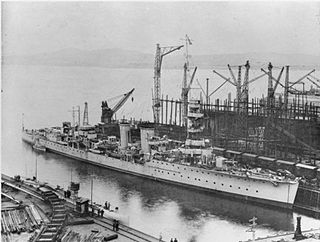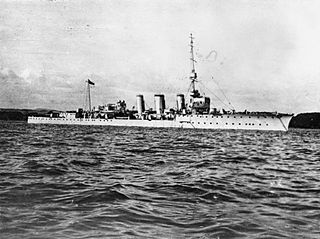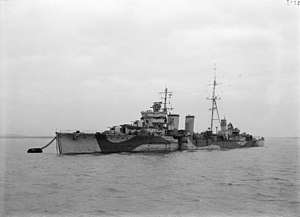Design and description
The Caledon sub-class was a slightly larger and improved version of the preceding Centaur sub-class with a more powerful armament. The ships were 450 feet 6 inches (137.3 m) long overall, with a beam of 42 feet 3 inches (12.9 m) and a deep draught of 18 feet 9 inches (5.7 m). Displacement was 4,238 long tons (4,306 t ) at normal and 4,911 long tons (4,990 t) at deep load. [2] Caledon was powered by two Parsons steam turbines, each driving one propeller shaft, which produced a total of 40,000 shaft horsepower (30,000 kW). The turbines used steam generated by six Yarrow boilers which gave her a speed of about 29 knots (54 km/h; 33 mph). She carried 935 long tons (950 t) tons of fuel oil. The ship had a crew of about 400 officers and ratings; this increased to 437 when serving as a flagship. [3]
The main armament of the Caledon-class ships consisted of five BL 6-inch (152 mm) Mk XII guns that were mounted on the centreline. One gun was forward of the bridge, two were fore and aft of the two funnels and the last two were in the stern, with one gun superfiring over the rearmost gun. The two QF 3-inch (76 mm) 20-cwt anti-aircraft guns were positioned abreast of the fore funnel. The torpedo armament of the Caledons was four times more powerful than that of the Centaurs, with eight 21 in (533 mm) torpedo tubes in four twin mounts, two on each broadside. [3]
Caledon was converted at the end of 1943 to an anti-aircraft cruiser, replacing the entire former armament with three QF 4-inch (100 mm) Mk XVI twin and two Bofors 40-millimetre (1.6 in) Mk IV "Hazemeyer" twin mounts. By 1944 this was supplemented by six Bofors 40 mm Mk III and one Oerlikon 20-millimetre (0.79 in) Mk III single mounts. The ship's tonnage increased to 5,240 long tons (5,320 t ) at full load, including 200 tons of lead ballast. [1]
Construction and career
She was laid down by Cammell Laird on 17 March 1916, launched on 25 November 1916 and commissioned into the Navy on 6 March 1917. [3] Caledon, commanded by Commodore Walter Cowan, saw action in the Second Battle of Heligoland Bight, where the ship was the leader of the First Light Cruiser Squadron. During the battle, British light cruisers, including Caledon, supported by the First Battlecruiser Squadron, attempted to cut off and destroy a force of German minesweepers escorted by light cruisers. The engagement developed into a chase with the German ships retreating behind smoke screens. The pursuit broke off when the British cruisers came under fire from the German battleships Kaiser and Kaiserin, which were deployed as a distant covering force for the German minesweeping operation. Caledon was hit by a single 305-millimetre (12.0 in) shell from one of the German battleships which failed to explode, and did no damage. [4] [5] Throughout the battle, five men of Caledon's crew were killed, with one man, John Henry Carless being awarded a posthumous Victoria Cross for remaining at his gun after receiving a fatal wound. [6] [7] Caledon survived the First World War. [3]
Caledon took part in the British naval intervention in the Baltic in 1919, serving as Rear Admiral Cowan's flagship for a force of two cruisers (Caledon and Royalist and five destroyers that sailed for the Baltic in January 1919. [8] Caledon shelled Soviet forces at Ventspils during February, helping Latvians to retake the town, before being returning to the United Kingdom later that month, with British naval forces in the Baltic being relieved every six weeks. [9] Caledon returned to the Baltic, again as Cowan's flagship, in April 1919, but was relieved by Curacoa in May. [10] Caledon returned again in July. [11]
The ship spent the early part of the Second World War with the Home Fleet, where she escorted convoys and was involved in the pursuit of the German battleships Scharnhorst and Gneisenau after the sinking of HMS Rawalpindi. She was reassigned to the Eastern Fleet between August 1940 and September 1942. Caledon then rejoined the Home Fleet. Upon her arrival in the UK, she underwent conversion into an anti-aircraft cruiser at Chatham Dockyard between 14 September 1942 and 7 December 1943, replacing the entire armament with modern AA weaponry. Obsolete by the end of the war, she was disarmed in April 1945, and subsequently sold for scrap on 22 January 1948. Caledon arrived at the yards of Dover Industries, Dover, on 14 February 1948 to be broken up. [12]

HMS Cardiff was a C-class light cruiser built for the Royal Navy during World War I. She was one of the five ships of the Ceres sub-class and spent most of her career as a flagship. Assigned to the Grand Fleet during the war, the ship participated in the Second Battle of Heligoland Bight in late 1917. Cardiff was briefly deployed to the Baltic in late 1918 supporting anti-Bolshevik forces during the British campaign in the Baltic during the Russian Civil War.

HMS Courageous was the lead ship of her class of three battlecruisers built for the Royal Navy during the First World War. Designed to support the Baltic Project championed by First Sea Lord John Fisher, the ship was very lightly armoured and armed with only a few heavy guns. Courageous was completed in late 1916 and spent the war patrolling the North Sea. She participated in the Second Battle of Heligoland Bight in November 1917 and was present when the German High Seas Fleet surrendered a year later.

HMS Malaya was one of five Queen Elizabeth-class battleships built for the Royal Navy during the 1910s. Shortly after commissioning in early 1916, she participated in the Battle of Jutland as part of the Grand Fleet. Other than that battle, and the inconclusive Action of 19 August, her service during the First World War mostly consisted of routine patrols and training in the North Sea.

The Courageous class consisted of three battlecruisers known as "large light cruisers" built for the Royal Navy during the First World War. The class was nominally designed to support the Baltic Project, a plan by Admiral of the Fleet Lord Fisher that was intended to land troops on the German Baltic Coast. Ships of this class were fast but very lightly armoured, with only a few heavy guns. They were given a shallow draught, in part to allow them to operate in the shallow waters of the Baltic but also reflecting experience gained earlier in the war. To maximize their speed, the Courageous-class battlecruisers were the first capital ships of the Royal Navy to use geared steam turbines and small-tube boilers.

HMS Vindictive was a warship built during the First World War for the Royal Navy (RN). Originally designed as a Hawkins-class heavy cruiser and laid down under the name Cavendish, she was converted into an aircraft carrier while still being built. Renamed in 1918, she was completed a few weeks before the end of the war and saw no active service with the Grand Fleet. The following year she participated in the British campaign in the Baltic against the Bolsheviks during which her aircraft made numerous attacks against the naval base at Kronstadt. Vindictive returned home at the end of the year and was placed in reserve for several years before her flight decks were removed and she was reconverted back into a cruiser. The ship retained her aircraft hangar and conducted trials with an aircraft catapult before she was sent to the China Station in 1926. A year after her return in 1928, she was again placed in reserve.

The BL 15-inch Mark I succeeded the BL 13.5-inch Mk V naval gun. It was the first British 15-inch (381 mm) gun design and the most widely used and longest lasting of any British designs, and arguably the most efficient heavy gun ever developed by the Royal Navy. It was deployed on capital ships from 1915 until 1959, and was a key Royal Navy gun in both World Wars.

HMS Curacoa was a C-class light cruiser built for the Royal Navy during the First World War. She was one of the five ships of the Ceres sub-class and spent much of her career as a flagship. The ship was assigned to the Harwich Force during the war, but saw little action as she was completed less than a year before the war ended. Briefly assigned to the Atlantic Fleet in early 1919, Curacoa was deployed to the Baltic in May to support anti-Bolshevik forces during the British campaign in the Baltic during the Russian Civil War. Shortly thereafter the ship struck a naval mine and had to return home for repairs.

The Highflyer-class cruisers were a group of three second-class protected cruisers built for the Royal Navy in the late 1890s.

HMS Colombo was a C-class light cruiser built for the Royal Navy during World War I. She was part of the Carlisle sub-class of the C class. She survived both world wars to be scrapped in 1948.

HMS Curlew was a C-class light cruiser built for the Royal Navy during World War I. She was part of the Ceres sub-class of the C class. The ship survived World War I to be sunk by German aircraft during the Norwegian Campaign in 1940.

HMS Cassandra was a C-class light cruiser of the Royal Navy. She was part of the Caledon group of the C class of cruisers. Cassandra had a short career, being commissioned in June 1917 and sunk by a mine during the British intervention in the Russian Civil War on 5 December 1918.

HMS Caradoc was a C-class light cruiser built for the Royal Navy during World War I. She was one of the four ships of the Caledon sub-class. Assigned to the Grand Fleet during the war, the ship participated in the Second Battle of Heligoland Bight in late 1917. Caradoc was briefly deployed to the Baltic in late 1918 supporting anti-Bolshevik forces during the British campaign in the Baltic and then was transferred to the Mediterranean Fleet in early 1919 and spent the next year and a half doing the same thing in the Black Sea during the Russian Civil War. The ship was withdrawn from the Black Sea in mid-1920 to observe the Greco-Turkish War of 1919–22 and the Chanak Crisis of late 1922. Caradoc spent most of the rest of her time between the World Wars overseas or in reserve with deployments to the Far East and the North America and West Indies Station.

HMS Cambrian was a C-class light cruiser built for the Royal Navy during World War I. She was the name ship of her sub-class of four ships. Assigned to the Grand Fleet upon completion in 1916, the ship played only a small role during the war. Cambrian was assigned to the Atlantic and Mediterranean Fleets during the 1920s and was sent to support British interests in Turkey during the Chanak Crisis of 1922–1923. The ship was placed in reserve in late 1929. She was sold for scrap in 1934.

HMS Carysfort was a C-class light cruiser built for the Royal Navy during World War I. She was one of six ships of the Caroline sub-class and was completed in 1915. Assigned to the Grand Fleet, the Harwich Force, and the Dover Patrol during the war, the ship served as a flagship for part of the war. Her only known combat was a short battle against German torpedo boats in the English Channel, although she was very active patrolling the North Sea and unsuccessfully searching for German ships. Carysfort was assigned to the Home and Atlantic Fleets after the war and was sent to the Mediterranean Fleet during the Chanak Crisis of 1922–23 to support British interests in Turkey. In 1922, she patrolled off the Irish coast during the Irish Civil War. The ship was placed in reserve after returning home in 1923 and, aside from ferrying troops overseas, remained in reserve until she was sold for scrap in 1931.

HMS Cordelia was a C-class light cruiser built for the Royal Navy during World War I. She was one of six ships of the Caroline sub-class and was completed at the beginning of 1915. The ship was assigned to the 1st and 4th Light Cruiser Squadrons (LCS) of the Grand Fleet for the entire war and played a minor role in the Battle of Jutland in mid-1916. Cordelia spent most of her time on uneventful patrols of the North Sea. She spent most of 1919 as a training ship before she was recommissioned for service with the Atlantic Fleet in 1920. The ship was placed in reserve at the end of 1922 and was sold for scrap in mid-1923.

HMS Hawkins was the lead ship of her class of five heavy cruisers built for the Royal Navy during the First World War, although the ship was not completed until 1919. She was assigned to the China Station until 1928 and was briefly assigned to the Atlantic Fleet in 1929–1930, always serving as a flagship, before being placed in reserve. Hawkins was recommissioned in 1932 for service on the East Indies Station, but returned to reserve three years later. The ship was disarmed in 1937–1938 and converted into a cadet training ship in 1938.

The Active-class cruisers were a trio of scout cruisers built for the Royal Navy shortly before the First World War. They were initially assigned to the First Fleet and became destroyer flotilla leaders in 1914. Amphion and Fearless and their flotillas were assigned to the Harwich Force when the war began in August 1914. They went out on a patrol on the first day of the war and Amphion and her destroyers encountered and sank a German minelayer. On the voyage home, the cruiser struck a mine laid by the German ship and sank. She was the first ship of the Royal Navy to be sunk in the war.

The Pathfinder-class cruisers were a pair of scout cruisers built for the Royal Navy in the first decade of the 20th century. The sister ships spent much of the first decade of their careers in reserve. When the First World War began in August 1914 they were given coastal defence missions, Pathfinder on the coast of Scotland and Patrol on the coast of Yorkshire. The latter ship was badly damaged when the Germans bombarded Hartlepool in December. She spent the rest of the war in British waters. The ship was paid off in 1919 and sold for scrap the following year. Pathfinder was sunk by a German submarine shortly after the war began, the first sinking of a British warship during the war by a German submarine.

The Challenger-class cruisers were a pair of second-class protected cruisers built for the Royal Navy in the first decade of the 20th century. One ship, HMS Encounter, was later transferred to the Royal Australian Navy.

The fifth HMS Valorous, ex-HMS Montrose, was a V-class flotilla leader of the British Royal Navy that saw service in World War I, the Russian Civil War, and World War II.



















